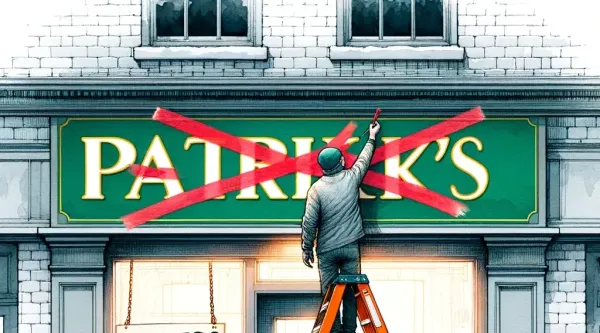The Mop-Up #3: MoP Fixes the News Business
"I don’t know, but I am not ready to leave our democracy in the hands of citizen journalists on TikTok."

BASSEY: By now you’ve read our headline, I hope. So… whew, where do we even begin? How’s this, Erica – It’s January 24th, but I think it’s fair to say that this will not be a banner year for the news industry. I could stitch media’s collective woe onto a tasseled canvas to make a point, but our growing stockpile requires bullets at this point:
- Conde Nast has shut down Pitchfork and is merging it with GQ, as their staff walks out to protest layoffs.
- Sports Illustrated is apparently cooked now that The Arena Group has refused to pay its licensing fees.
- Layoffs at legacy stalwarts Time Magazine and NBC News
- The Baltimore Sun has been sold to political interests who think the news would be totally fixed if it simply blamed everything on “woke” people.
- The LA Times, bought out by a local billionaire to much fanfare years ago, now faces staff cuts down the levels of the crisis that attracted said billionaire in the first place.
Meanwhile, local news spirals toward systematic collapse. Brian Morrissey in The Rebooting might well be a wide-eyed optimist when he writes: “What will emerge the day after will be a different industry, leaner and diminished, often serving as a front operation to other businesses.”
So, Erica! No pressure at all, but how do we get out of this mess as a society?
ERICA: I don’t know, but I am not ready to leave our democracy in the hands of citizen journalists on TikTok.
My suggestion is that we look to strategy sage Richard Rumelt, author of Good Strategy/Bad Strategy and advisor to major corporations and government organizations. (One optimistic thought is that it can’t be harder to find a sustainable business model for journalism than it is to clean up the messes created by the U.S. military.)
Rumelt preaches that we throw out the pointless vision statements, stop pretending goals are strategy and name the specific challenges we’re facing. “Try to identify the one or two key challenges that can actually be addressed and what are we going to do about it?” he advised in a recent interview. And don’t call it a strategy, call it an Action Agenda. No room for fluff in an Action Agenda.
Hard problems are solved through radical honesty about the challenge and fearless creativity in our solutions. You asked how we get out of this mess? My answer is that we name the specific problems that are causing mass layoffs of journalists, and then we brainstorm concrete actions to crawl ourselves out of the hole. This should be fun since we don’t actually run a news company, no stakes!
So let’s put on our brainstorming hats and try out some ideas.
BASSEY: In my defense, most of those vision statements were just so I had something to show my boss while I worked through the actual problem, but that sounds like great advice! I think it’s easier to think in terms of local news since the problems are well-defined and ideas can scale nationally.
How’s this – local media’s earnings decline as the actuarial table advances because their format and delivery has become unmoored from our physical lives. Delivering a paper to stack on top of my books and coupons makes sense. Putting a paper beside my phone where I can get news from London faster than I can continue reading on page 4, less so.
This change has helped lead us toward more isolated lives – is paying for a subscription as critical when your friends aren’t debating the latest news from downtown or that messed up crossword puzzle clue? (Paying for a small website I can’t touch? Why bother?) In what ways are young people in the area physically joining in community with one another outside of school and sports?
Let’s solve this in one fell swoop by building hyperlocal media around event spaces. Most states have ever-shrinking culture budgets. So, our space is in a boarded up storefront downtown, available for rental, with discounts for politicians. On some nights, we even turn it into a 16 or 18+ club since there is so little for teenagers to do in public spaces together. Meanwhile, we run an app filled with obsessive coverage about the event space and cool things to do, but sneakily, it grows into a de facto news publication meant to attract events somehow related to the news.
One key addendum: We can’t get bogged down in tech. At some point, the app will be feature complete and we won’t update it at all for, like, three years. Eventually some AI hobbyist or nonprofit will help build AI things and we all live happily ever after.
Have… have I done it? Has the political-cultural collapse been averted?
ERICA: Almost! I love the idea of building a space that generates news, and then reporting on the news. But you didn’t mention “revenue.” Let me try to fill in the blanks.
The challenge is that local papers require an engaged community so that people pay money to follow local plotlines ($$) and consume ads as they read ($$). The underinvestment in physical community spaces has led to a fraying of communities and the computers in our pockets mean our heads are engaged in issues far from home. The solution is to build community by stapling an events business onto the news business. The revenue comes from event sponsors, ticket sales, space rentals and we flywheel the community engagement into paper subscriptions. I’m into it!
I have another idea for you, this one stolen (with permission) from friend-of-the-newsletter Andrew Gruen.
One challenge facing newspapers is that the internet has hollowed out the value of service journalism. Papers used to provide low-effort, medium-value content such as sports scores, election results, weather reports and stock prices that are now a Google search away. But maybe there’s a new version of service journalism?
Andrew’s idea is to glue a data business onto a newspaper business. What if a paper provided a service for residents to query data about the community? What did my neighbor pay in property taxes last year? How have the high school’s AP calculus scores changed since the new principal started? Has the local reservoir ever failed a water test?
The tech layoffs have made software engineers cheaper, the modern data stack has made data engineering easier and — forgive me — generative AI means that LLMs can (almost) automatically turn human queries into SQL queries and then into data visualizations. Oh, and the revenue comes from the paper charging for access and privacy guarantees so you can snoop on your neighbors with ease and peace of mind.
BASSEY: Wow, the capitalism is strong within you! But you’re totally right – this is (regrettably) not a Hallmark movie where I try to fix journalism in a small town over Christmas and fall in love with the grumpy, but kindhearted local editor-in-chief.
It’s hard for me, though, to get my arms around finding more than triple-digit customers for a local data-broker product. The answer is probably a subscription, but is this idea hamstrung by social taboos that make word of mouth difficult in some cases, and an elite audience that gets enough data themselves in the others? I honestly don’t know the answer to that question, but in the Rumelt-ian spirit, I’ll try to take the problem on directly.
We know “snooping” is an attractive product, but our product needs to spread organically in social circles without taboo. So how about data on what everyone is doing with a strong tie to sense-of-place?
It’s well known that organic social network activity falls when the barrier to entry for an ‘average’ post gets too high. This is why Instagram had to pour so much energy into Stories – posts became too high-end for daily use thanks to all of the influencers in our feeds.
So how about we push micro-updates on everything everyone local creates from a cultural standpoint? Truly, a clearinghouse of advice, encouragement and ‘huh, that’s weird.’ From upgrades to your local business as small as a new artificial tree, to structured feedback on a new song or flowerbed, the system is designed for the community at-large to beta-test each others’ everything in some systematic way.
You’re a local business? Let’s chat about individual menu items or debate the three different end-tables you have in stock. Community board meeting? Here’s a ranking of the 10 most interesting things anyone said. It’s geo-fenced, and the bulletin board manager digitally runs for reelection every so often. This way, when we query the LLM, we can ask questions normal non-supernerds might have. Such as: Who has the best flowers in my neighborhood, and when is Tommy hosting Dominoes night, again? What are the newest menu items at the Diner?
Also, yes, this is just a message board with an LLM strapped to its back with a picayune stuffed inside.
ERICA: Sign me up for micro-updates on my neighborhood served through a friendly LLM. My first question would be about that bakery on Grand St. that looks like a sweatshop and smells of rotting brioche. There’s still the pesky issue of revenue (subscription model?) and whether Reddit has this market cornered, but it’s a compelling idea!
The key to making any of these ideas work is to find some synergy between the new business and the competitive advantage of the newspaper. “Do newspapers have competitive advantages in 2024?” you ask. Certainly! They no longer have an advantage in advertising, but they still have what Rumelt calls “sources of power.” The power to convene, the power to fact check, the power that comes from the reputation of their brand. The head of marketing at Lowes may have an army of advertising technicians, but they likely do not know that the town's snowplows broke down last year and everyone is poised to buy their own snowblowers for the upcoming winter. That is power.





Comments
Sign in or become a Machines on Paper member to join the conversation.
Just enter your email below to get a log in link.